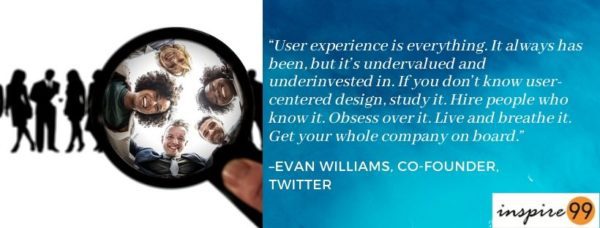User Experience: Whether it is a B2B or B2C product, the software cannot escape good UX. People ignore products that ignore users. As an entrepreneur, it is hard to have funds to afford good design. This is where you’d need to decide whether to go for a Minimum Viable product or Minimum Lovable product approach. Generally, the lovable product approach suits the crowded market space. Assuming an entrepreneurial route, I’m inclined to think of the MVP approach.
“User experience is everything. It always has been, but it’s undervalued and under invested in. If you don’t know user-centred design, study it. Hire people who know it. Obsess over it. Live and breathe it. Get your whole company on board.”
–Evan Williams, Co-Founder, Twitter
User Experience for early releases
Make sure you think about your first release. Consider the differences between a beta release and a full release. A beta release usually is with a restricted group where you can set the expectations. This is a great opportunity to gather customer feedback and improve. Users will appreciate that it is in the early stages and adjust their expectations accordingly.
You might not be able to hire the best UX to work on the design. But you can still consider other elements such as flow, user journey etc to make sure you create a decent prototype for the customers.

Also, consider wireframes and design mapping. It can be an easy and cheap way to gather customer feedback quickly. Instead of having to spend money on product development, you might be able to get feedback more quicker.
Customer touch points
Your user experience starts with the customer touchpoints. This is perhaps the foremost consideration of design/ user experience. A touchpoint is the communication facet with your end customer. This is more important in a B2C segment compared to B2B. The touchpoints help you define areas of focus for your software.
Sales conversations Vs Design
End of the day, a business is driven by revenue. It is of course represented in various formats. For traffic is driven website/experience, it might literally be the bounce rate, the number of visitors, shares, likes etc.
These further connect straight to advertising revenue and sponsored content, etc. For such software, the focus is on driving user attention straight to the point and conveying the impact of a brand in very few words or designs. The key trick of a user experience in this regard is the drive to a commercial design at the quickest.
Customer Dialogue and Feedback
Unfortunately, user experience sometimes forgets that it is about a customer dialogue and not really a one-sided communication. Many software, throw lots of information at an end-user to the extent of annoying the user. Make sure you get the right balance. Also create sufficient channels for customers to give you feedback.
Consider your go-to-market strategy, whether it will be a Freemium model or a free tier. Make sure that you have allowed customers to talk to you at different stages of the journey. Track their behaviour, gather feedback and iterate.
Span of Attention
With the increasing number of applications on the app store or google play, one cannot afford to lose a lot of time in bad user experiences. Given the attention span is so little, if the user experience is a little lacking, it gets the boot quickly. Although it falls well within the concept of fail fast fail cheap for a startup, it is equally difficult to be resilient in the pace at which some of these developments move.
For this very purpose, it is extremely useful to have a focus group or user group which can act as your primary sample who help and aid you to get to the real user base. If you are questioning this point – try looking at the statistics of how many apps get uninstalled within the first month.
Value Addition in User Experience
Too much of anything is never a good sign. A business/product development is all about the balance of key resources and most importantly time. We all have a limited supply of each of these and cannot afford to over-engineer only one aspect.
The endpoint of any business is the value offered to a customer. If that’s absent, no matter how great the user experience is, the software or the business reaches its impending doom. For a business, the pressure is in continually maintaining value addition at each stage of the business. This very well applies to the user experience element to the user.
“User experience is everything. It always has been, but it’s undervalued and underinvested. If you don’t know user-centered design, study it. Hire people who know it. Obsess over it. Live and breathe it. Get your whole company on board.”
–Evan Williams, Co-Founder, Twitter
